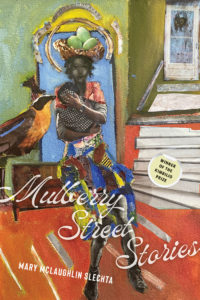 Review by Laura Dennis
Review by Laura Dennis
I know Syracuse, or at least I thought I did. My mother’s family lives just north of that city in the heart of New York’s snowbelt, homeland of the Onondaga. All that changed when I entered the world of Mary McLaughlin Slechta’s Mulberry Street Stories. In this 25-piece story cycle, a cast of recurring characters moves between past and present, between this world and an adjacent one not visible to all. The vast majority of the stories, many short enough to qualify as flash, are narrated in the third person, with three told in first person, and one, which reads like a guided tour, in the second person “you.”
The title brings to mind nursery rhymes, especially “Here We Go ‘Round the Mulberry Bush” or “Pop! Goes the Weasel.” As I read, I recalled “Ring Around the Rosie” too, although the children’s story that most directly informs the text is Dr. Seuss’s And to Think That I Saw It on Mulberry Street, for which Slechta named the setting. This may in part be due to Seuss’s fantastical accumulation of sounds and images, for Slechta’s vivid prose is not dissimilar, at once playful and terrifying, hilarious and devastating, prosaic and strange. More than that, however, this story cycle provides a vital correction to the racist illustrations and tropes of the 1937 children’s book, one of six the author’s estate withdrew from publication in 2021.
Readers also become aware of other influences as they move through the tales. They may remember Colson Whitehead’s Pulitzer-winning The Underground Railroad or find themselves recalling Gabriel García Márquez and Isabel Allende. Like these authors, Slechta uses magical realism to explore difficult topics, including poverty, drug use, and above all racial injustice in all its forms. This, along with shifting points of view between stories, allows us to view the same events from multiple angles, events which include hate crimes, an unjust imprisonment, and a devastating conflagration referred to as “The Fire.” We learn to pay attention to everything and everyone, including those most often dismissed or ignored—the women, the very young, and the very old; the ghosts, zombies, and vampires; the voices emanating from bellies and sidewalk cracks. We do not always know what is real nor what time we are in, nor does it matter. The deeper I went in the book, the more I found my questions answered, each revelation a key to a secret world.
Two such keys can be found in the recurring appearance of the Underground Railroad, which at moments feels as literal as Whitehead’s, and of a presumed panhandler holding a sign on which is written “hope.” Syracuse was an important stop on the Underground Railroad, and yet given the suffering these characters experience, one has to wonder if the initial hope promised by the journey has even been fulfilled. In addition to the painful events depicted, some characters dismiss the street as snobbish, while others find it too run-down.
In the end, Mulberry Street is all these things and also a whole lot more, a place that allows us to frame hope not as a zero-sum game, but as something we can choose. After all, “an ounce of hope gets you to the next stop,” as the panhandler affirms. While these characters are sometimes cruel and deceptive, they also show up for each other in important ways: “You needed help shoveling or got stuck in the snow? Someone was out of their house, their bed, to help you get to work on time. People paid attention on Mulberry Street.” In other words, like all communities, Mulberry Street is not just one thing. It cannot be easily defined or contained.
It is never too late to rethink the things we once accepted as true. The Seuss estate understood that when they withdrew those books, and I understood it as I found whole new worlds, both real and fantastical, within the city that, though unnamed in the text, is clearly Syracuse. It is not too late for the story’s characters, and it is not too late for us. I am challenged, I am fascinated, I am moved. That is the hope that literature provides.
Mulberry Street Stories by Mary McLaughlin Slechta
Four Way Books 2023 $19.95 [paper]
ISBN: 978-1-954245-74-7 / eISBN: 978-1-954245-75-4
Laura Dennis teaches world languages in Appalachia and co-edits book reviews for MER. She has published book reviews and her own creative work in a variety of outlets, including MER Vox Quarterly, Still: The Journal, Change Seven, McNeese Review, Red Branch Review, Bluff & Vine, and Northern Appalachia Review.
